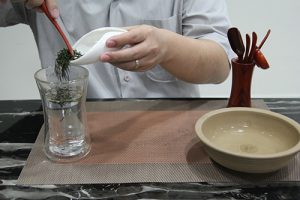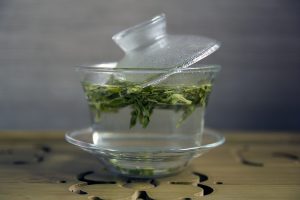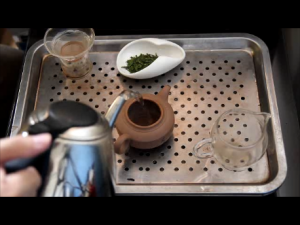Yes, you are on the right site. Though this blog is all about Japanese teas, this post is not here by mistake. After all, lovers of quality tea will find some of what is alluring in gyokuro present in bi luo chun as well.
In terms of brewing methods though, there is quite a bit of difference from technique to equipment. Diversity is part of what makes tea the most alluring drink in the world, at least in my admittedly biased opinion.
The Chinese style of brewing green tea can be broadly categorized into 3 main types-
- Top Drop (上投法)
- Bottom Drop (下投法)
- Mid Drop (中投法)
We will use an example to illustrate each of the 3:
Top drop glass brewing- xinyang maojian (信阳毛尖)
 As its name suggests, the top drop method means that the tea leaves are added to the ‘top’ of the vessel, or in other words, the leaves are added after the hot water.
As its name suggests, the top drop method means that the tea leaves are added to the ‘top’ of the vessel, or in other words, the leaves are added after the hot water.
This method is suited for delicate tea leaves, as the force of pouring water might break the brittle leaves. To avoid this, add the leaves after the hot water, and they will slowly sink and unfurl elegantly.
To observe the beauty of this, a tall glass would be an ideal pairing.
Using xinyang maojian, here are the basic steps:
- Warm the glass with hot water and discard
- Fill the glass to about 70% with water of approximately 80⁰C
- Add about 1g of tea leaves for every 50 ml of water
- Allow the tea to infuse for 2-3 minutes
- Drink until the tea is about 1/3 full and refill
- Repeat another time
- Drink and discard the wet leaves
Bottom drop gaiwan brewing- xihu longjing (西湖龙井)
 Bottom drop is the most commonly used method and is used in most types of teas other than green teas. In green teas though, this is most suited for flat leaves that would tend to float such as longjing, taiping houkui and dinggu dafang.
Bottom drop is the most commonly used method and is used in most types of teas other than green teas. In green teas though, this is most suited for flat leaves that would tend to float such as longjing, taiping houkui and dinggu dafang.
We will use a gaiwan (盖碗) to brew xihu longjing, the most famous Chinese green tea. The gaiwan will help extricate the full roasted beany fragrance of longjing.
One thing to note though, the lid of the gaiwan should only be partially covered as a fully covered lid will lead to an ‘over-stewing’ of the leaves, resulting in a brew that is yellow and lacking in briskness.
The sequence is as follows:
- Warm the gaiwan with hot water and discard
- Add 1g of tea leaves for every 50 ml of water
- Add water of approximately 80⁰C
- Allow the tea to infuse for about 2 minutes
- Pour the liquor into a serving pitcher and decant completely
- Serve
- Repeat steps 3-6 another 3 times
Mid drop pot brewing- huangshan maofeng (黄山毛峰)
 Then there is the mid drop method. By now you probably caught on the trend and inferred that mid drop is adding the leaves after the water is filled halfway. This method is more for bud shaped leaves such as huangshan maofeng.
Then there is the mid drop method. By now you probably caught on the trend and inferred that mid drop is adding the leaves after the water is filled halfway. This method is more for bud shaped leaves such as huangshan maofeng.
Generally, tea pots are not favored for green tea as it tends to ‘over-stew’ the delicate leaves but huangshan maofeng is an exception as it is protected by half-grown leaves that render it more resilient to heat.
A point to note is that the pot should be less than 250ml (8.3 oz) as too big a vessel will overheat the leaves as well.
Here are the basic steps:
- Warm the pot with hot water and discard
- Add hot water to about 1/3 of the pot
- Add 1g of tea leaves for every 50 ml of water
- Add water of approximately 85⁰C
- Allow the tea to infuse for about 2 minutes
- Pour the liquor into a serving pitcher and decant completely
- Serve
- Repeat steps 4-7 another 2 times
About the author:
Derek Chew has never met a well-made oolong tea he didn’t adore but has more than the occasional flirtation with green teas and recently started making eyes at Sheng Pu-er.
Derek also owns and operates Peony Tea S- a Singapore based teashop committed to helping tea lovers of all levels of experience find their perfect cup of tea. Update: Unfortunately the store closed permanently in 2015.

March 13, 2013
Thank you for sharing this informative blog post! I will have to try your different methods. I have never used a gaiwan before. Looks like I may have to get one!
Also, I am looking for some terrific matcha. Any suggestions?
March 13, 2013
Hi Laura
I’ll be slowly adding tea reviews to the blog, but for now how about Matcha Source? http://matchasource.com/
I also bought my matcha bowl and chasen there.
March 14, 2013
Thanks Ricardo! I will check your link out now.
Cheers!
March 16, 2013
A useful blog post.
March 21, 2013
This is a good blog (^_^) It’s good to know mod’s who are knowledgeable and enthusiastic of their subject.
October 17, 2013
awesome blog,thanks for sharing many information about Brewing Chinese Green Tea